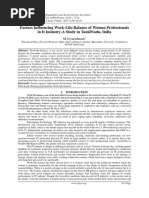Introduction To Normal Distribution
Uploaded by
Jojo BasarIntroduction To Normal Distribution
Uploaded by
Jojo Basar### Introduction to Normal Distribution
Normal distribution, often referred to as the Gaussian distribution, is a fundamental concept in statistics
and probability theory, characterized by its bell-shaped curve. This distribution is pivotal in various fields,
including psychology, biology, finance, and social sciences, as it provides a natural model for a wide range
of real-world phenomena. One of the defining features of the normal distribution is its symmetry around
the mean, which serves as both the center and the average of the distribution. Approximately 68% of the
data falls within one standard deviation of the mean, 95% within two standard deviations, and 99.7%
within three standard deviations, making it a key reference point for statistical inference.
The normal distribution is defined by two parameters: the mean (µ) and the standard deviation (σ). The
mean determines the location of the center of the distribution, while the standard deviation measures
the dispersion or spread of the data around the mean. Mathematically, the probability density function
(PDF) of a normal distribution is given by:
\[
f(x) = \frac{1}{\sigma \sqrt{2\pi}} e^{-\frac{(x - \mu)^2}{2\sigma^2}}
\]
This function illustrates how probabilities are distributed across the range of possible values, highlighting
the characteristics of normality. The empirical rule, which describes the distribution of data in terms of
standard deviations from the mean, further emphasizes the importance of the normal distribution in
understanding variability in data.
One of the most significant reasons for the widespread use of normal distribution in statistics is the
Central Limit Theorem (CLT). The CLT states that, regardless of the original distribution of the data, the
sampling distribution of the sample mean will approach a normal distribution as the sample size
increases. This property underpins many statistical methods, including hypothesis testing and confidence
intervals, allowing researchers to make inferences about population parameters with greater confidence.
In conclusion, normal distribution is a cornerstone of statistical theory and practice, offering a powerful
framework for understanding and analyzing data. Its unique properties, such as symmetry and the
Central Limit Theorem, make it indispensable for a wide array of applications, from designing
experiments to conducting surveys. As the importance of data analysis continues to grow in various
disciplines, the normal distribution will remain a central focus for researchers seeking to draw
meaningful conclusions and make informed decisions based on statistical evidence.
You might also like
- DOMINION (2014-15) - Complete TV Series and LEGION Movie - 720p BluRay x264100% (1)DOMINION (2014-15) - Complete TV Series and LEGION Movie - 720p BluRay x2642 pages
- Rabonni Sonatas For Flute and Piano Nr. 13-24 - Piano Only (Book2)100% (1)Rabonni Sonatas For Flute and Piano Nr. 13-24 - Piano Only (Book2)69 pages
- Learning Activity Sheet: Ip Addressing and Subnet MaskNo ratings yetLearning Activity Sheet: Ip Addressing and Subnet Mask5 pages
- Normal Distribution: An Ultimate Guide: Data Science BlogathonNo ratings yetNormal Distribution: An Ultimate Guide: Data Science Blogathon7 pages
- Normal Distribution - Wikipedia, The Free EncyclopediaNo ratings yetNormal Distribution - Wikipedia, The Free Encyclopedia22 pages
- University School of Business (MBA) : SUBJECT NAME: Decision Science-II Subject Code: 20bat652No ratings yetUniversity School of Business (MBA) : SUBJECT NAME: Decision Science-II Subject Code: 20bat65215 pages
- MET 5 LESSON 1 - Characteristics Normal Random VariableNo ratings yetMET 5 LESSON 1 - Characteristics Normal Random Variable8 pages
- The Normal Distribution Is The Most Important and Most Widely Used Distribution in StatisticsNo ratings yetThe Normal Distribution Is The Most Important and Most Widely Used Distribution in Statistics2 pages
- The Normal Distribution Is The Most Important and Most Widely Used Distribution in StatisticsNo ratings yetThe Normal Distribution Is The Most Important and Most Widely Used Distribution in Statistics2 pages
- The Normal Distribution and Its PropertiesNo ratings yetThe Normal Distribution and Its Properties37 pages
- Normal distribution - WikipediaTheory of estimationNo ratings yetNormal distribution - WikipediaTheory of estimation61 pages
- Normal Distribution and Standard Normal DistributionNo ratings yetNormal Distribution and Standard Normal Distribution46 pages
- Chapter Ii. Lesson 1 The Normal Dist. TableNo ratings yetChapter Ii. Lesson 1 The Normal Dist. Table3 pages
- Introduction To The Normal Distribution Bell CurveNo ratings yetIntroduction To The Normal Distribution Bell Curve6 pages
- U04d1 Importance of The Normal DistributionNo ratings yetU04d1 Importance of The Normal Distribution2 pages
- Normal Distribution Normal Probability Distribution: Mean Continuous Random Variable (X)No ratings yetNormal Distribution Normal Probability Distribution: Mean Continuous Random Variable (X)5 pages
- Biostatistics Presentation Normal DistributionNo ratings yetBiostatistics Presentation Normal Distribution15 pages
- GLYSANTIN+G48+bg+PGS 000000000030052793 SDS GEN AU en 8-0No ratings yetGLYSANTIN+G48+bg+PGS 000000000030052793 SDS GEN AU en 8-011 pages
- Approaches To Curriculum: AUGUST 24, 2019No ratings yetApproaches To Curriculum: AUGUST 24, 201931 pages
- Secret Sheet Music For Piano (Solo) EasyNo ratings yetSecret Sheet Music For Piano (Solo) Easy1 page
- 5 Types of Fish Often Called As The 'Dragon Fish' by Eka RahmadhyNo ratings yet5 Types of Fish Often Called As The 'Dragon Fish' by Eka Rahmadhy3 pages
- Factors Influencing Work-Life-Balance of Women Professionals in It Industry-A Study in Tamilnadu, IndiaNo ratings yetFactors Influencing Work-Life-Balance of Women Professionals in It Industry-A Study in Tamilnadu, India8 pages
- Method of Test For Determining The Percent of Fractured FacesNo ratings yetMethod of Test For Determining The Percent of Fractured Faces2 pages
- Final Module 02 - Characteristics of An EntrepreneurNo ratings yetFinal Module 02 - Characteristics of An Entrepreneur8 pages
- The Agile Service Management Guide: by Jayne Gordon GrollNo ratings yetThe Agile Service Management Guide: by Jayne Gordon Groll34 pages
- Lehdonvirta Wu and Hawkins 2023 AIES Compute North Vs Compute SouthNo ratings yetLehdonvirta Wu and Hawkins 2023 AIES Compute North Vs Compute South11 pages

























































































